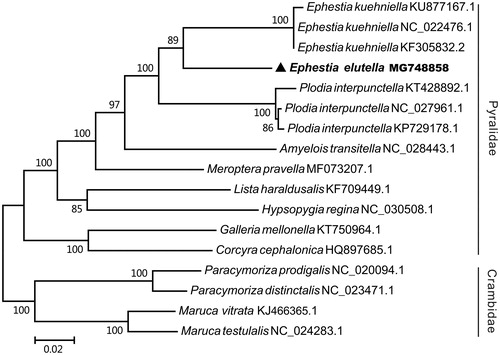Abstract
In this study, the complete mitochondrial genome of the tobacco moth Ephestia elutella was sequenced and analyzed. The mitochondrial genome is 15345 bp long and contains 13 protein-coding genes, two rRNA genes, 22 tRNA genes, and one control region. Twenty-three genes were found to be encoded by the majority strand and the other 14 genes by minority strand, those is similar to that of other insects. The nucleotide compositing of the majority strand are 38.6% of A, 11.77% of C, 42.05% of T and 7.58% of G. The phylogenetic analysis by Maximum-likelihood (ML) method revealed that the E. elutella was close to the same genus insect Ephestia kuehniella.
The tobacco moth Ephestia elutella (Hübner) (Lepidoptera: Pyralidae) is one of the main pests in stored tobacco, and it is cosmopolitan in distribution (Ashworth Citation1993). However, little information about its genetic characteristic has been reported. Therefore, we determined to sequence the complete mitochondrial genome of E. elutella using the De Novo sequencing techniques strategy, with the purpose to studying biogeographic, molecular, and population studies. The adult E. elutella was obtained from tobacco warehouses in Guiyang Tobacco Redrying Factory, Guiyang, China (GPS 26.52094°N, 106.67497°E), and then was reared on toacco in lab. The voucher specimens are deposited in Institute of Entomology, Guizhou University, Guiyang, China (GZU-LE-000019). The fourth larvae stage of E. elutella were washing with 70% ethanol first, and then those were stored in 95% ethanol, the mitochondrial DNA was extracted using De Novo sequencing library, and DNA sequencing at TGS (Total Genomics Solution Institute, Shenzhen, China).
The entire sequence of E. elutella mitochondrial genome (Genbank accession no. MG748858) is 15345 bp in length, consisting of 13 protein-coding genes (PCGs), 2 ribosomal RNA genes (rRNA), 22 transfer RNA genes (tRNA), and 1 control region. Twenty three genes (trnM, trnI, nad2, trnW, cox1, trnL2, cox2, trnK, trnD, atp8, atp6, cox3, trnG, nad3, trnA, trnR, trnN, trnS1, trnE, trnT, nad6, cytB, and trnS2) were found to be encoded by the majority strand and the other 14 genes (trnQ, trnC, trnY, trnF, nad5, trnH, nad4, nad4L, trnP, nad1, trnL1, rrnL, trnV, and rrnS) by minority strand, those is similar to that of other insects (Lin et al. Citation2017; Living Prairie Mitogenomics Consortium Citation2017; Singh et al. Citation2017). Overall nucleotide compositions of the majority strand are 38.6% of A, 11.77% of C, 42.05% of T and 7.58% of G, with an AT content of 80.65%.
All the protein-coding genes begin with ATN start codon except the cox1,which starts with CGA similar to other Lepidoptera insects (Singh et al. Citation2017); cox3, nad4, nad4L, and cyt b genes employing ATG; while the rest using ATA as a start codon. Three PCGs (cox2, nad5, and nad4) have aberrant single-nucleotide (T) stop codons, and the other PCGs showed canonical stop codon pattern TAA. The lrRNA is located between tRNAL1 and tRNAV, whereas srRNA is accommodated between tRNAV and control region. The 22 tRNA genes vary from 63 to 70 bp in length. The secondary structure of tRNAs exhibited typical clover-leaf structure similar to other insect species. The size of the control region is 319 bp (44.2% A, 1.25% G, 49.84% T, 4.7% C, with an AT content of 94.04%), and it located between srRNA and tRNAM, and the gene order around the control region is tRNAV-srRNA-control region-tRNAM-tRNAI-tRNAQ, and the order model was similar to other lepidopteran insects (Singh et al. Citation2017), and it is different to Coleopteran insects (Zhang and Hewitt Citation1997).
The phylogenetic tree of E. elutella was constructed with the complete mtDNA sequences from 13 pyralidea moth by MEGA 7.0 (Kumar et al. Citation2016) using maximum-likelihood (ML) methods(Chen et al. Citation2016; Liu et al. Citation2018). As shown in , the E. elutella was close to Ephestia kuehniella. Thus, this result supported the monophyly of E. elutella.
Disclosure statement
The authors report no conflicts of interest. The authors alone are responsible for the content and writing of this article.
Additional information
Funding
References
- Ashworth JR. 1993. The biology of Ephestia elutella. J Stored Prod Res. 29:199–205.
- Chen H, Deng S, Yang H, Ma X, Zhu C, Huang H, Li G. 2016. Characterization of the complete mitochondrial genome of Priacanthus tayenus (Perciformes: Priacanthidae) with phylogenetic consideration. Mitochondrial DNA Part B. 1:243–244.
- Kumar S, Stecher G, Tamura K. 2016. MEGA7: molecular evolutionary genetics analysis version 7.0 for bigger datasets. Mol Biol Evol. 33:1870–1874.
- Lin ZQ, Song F, Li T, Wu YY, Wan X. 2017. New mitogenomes of two Chinese stag beetles (Coleoptera, Lucanidae) and their implications for systematics. J Insect Sci (Online). 17:63.
- Liu Q, Jiang X, Hou X, Cai R, Tan J, Chen W. 2018. The mitochondrial genome of Lasioderma serricorne (Coleoptera, Anobiidae). Mitochondrial DNA Part B. 3:64–65.
- Living Prairie Mitogenomics Consortium. 2017. The complete mitochondrial genome of the lesser aspen webworm moth Meroptera pravella (Insecta: Lepidoptera: Pyralidae). Mitochondrial DNA Part B. 2:344–346.
- Singh D, Kabiraj D, Sharma P, Chetia H, Mosahari PV, Neog K, Bora U. 2017. The mitochondrial genome of Muga silkworm (Antheraea assamensis) and its comparative analysis with other lepidopteran insects. PLoS One. 12:e0188077.
- Zhang DX, Hewitt GM. 1997. Insect mitochondrial control region: a review of its structure, evolution and usefulness in evolutionary studies. Biochem Systemat Ecol. 25:99–120.

